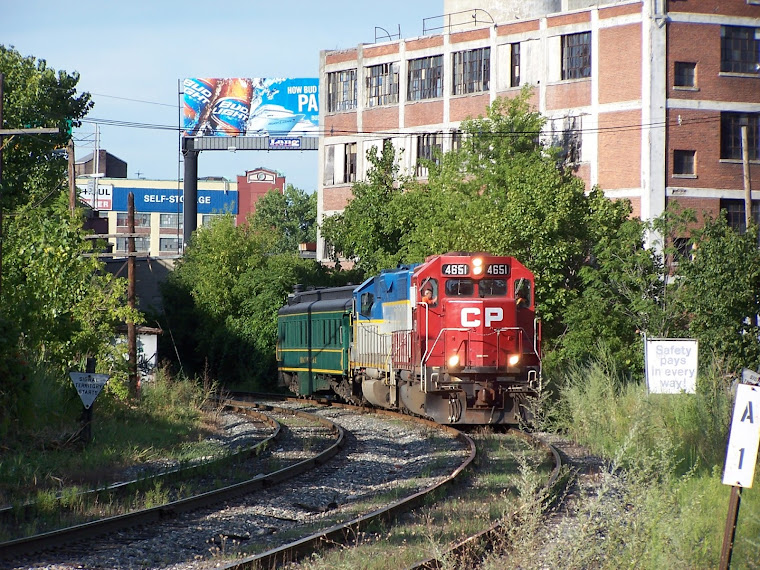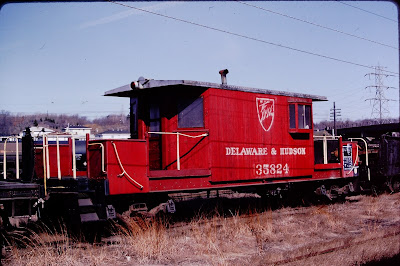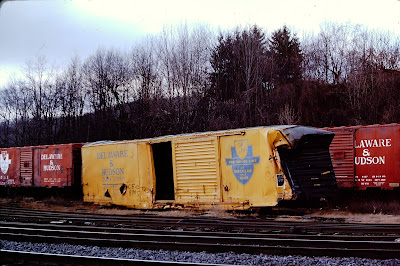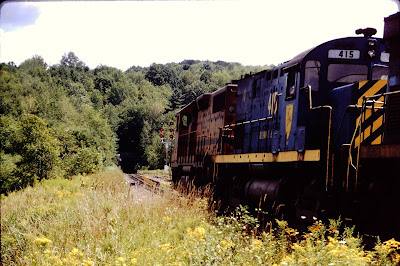This past year I have been tracking down some commercially available A&A models to include on my blog. In the process, I have met some wonderful people that I am happy to now call friends. Recently, I have been working on finding out more information related to some O gauge cars produced by Buffalo Creek Graphics. (Below are some A&A cars in Frank's collection)

Buffalo Creek Graphics is a company in Western NY (Buffalo and North Tonawanda areas) custom painting O gauge train cars in mostly shortline road names. They are mostly closed for business now.
Light Blue Boxcars (#507, #512, #521)
My interest started when I discovered that B.C.G. produced three light blue A&A boxcars around 2012. Their website had some information about these cars. I have been watching EBay for a long time to buy them but they rarely came up. Finally, I wrote to B.C.G. and asked if they had any left. The company's inventory was sold out, but John Slater offered to sell me the two in his collection (#512 and #517). Terms were agreed upon and the deal was reached, and he was kind enough to send a letter of provenance with them as well as a brief history of the cars.
The history of these cars is this: for the 2013 Nickle Plate Road HTS one of the planned events was riding the A&A. Inspired by that, John wanted to do some boxcars in the A&A's baby blue scheme. He, along with former owner Tom Gascoigne, contacted A&A General Manager George Ling and they all worked on the project together. Paint samples from an old A&A car that was in the yard were obtained by scraping paint from an area that was not subject to sun bleaching to ensure that it was the correct color blue. How is that for correct paint color accuracy? John did all of the artwork for the cars, and B.C.G. produced the cars in three road numbers. As noted, I obtained #512 and #517 from John. So I still needed #521 (though more on that later).
Orange & White MTH Boxcar (#507)
Then, months later while thumbing through an old issue of O Gauge Railroading magazine (Run 214) I came across an article from a layout tour in the 1990s of Frank Battaglia's layout. One of the pictures showed an orange and white A&A boxcar so I looked him up online and called him. We talked for a long time and discovered we had a lot in common, and that led to an invitation to come out and see his layout. Which we did. My wife and I, along with our dog, toured his house and layout he was a wonderful host. I also met Tom at that time, who was visiting that day and wanted to meet me. Did I mention that Frank and Tom were brother-in-laws? Sadly, Frank also wanted to make it out to meet me but couldn't.
It turns out that Frank's orange and white boxcar was actually an MTH car produced in 2002. I own two of them, one of which is the MTH factory prototype sample car. I am not sure why OGR magazine captioned the photo as being from the early 1990s if the boxcar was made in 2002, but oh well. Below are the two in my collection, as well as some other USTTC A&A cabooses. Its inclusion in the article sparked a wonderful friendship with Frank.

Red & Black Boxcar (#411)
I didn't realize there was even more to this story until I went to visit Frank's house and tour his layout in mid-October. Tom showed up because he wanted to meet me, and we started talking. He then proceeded to show me a red and black A&A boxcar which I knew nothing about, and I later learned belonged to Frank. I asked Tom about the history of this car, and here is what I found it. In 2009, in preparation for the 2009 Nickle Plate Road HTS convention being held in the Buffalo area, Tom wanted to do a special boxcar for the A&A as one of the convention events was going to be riding the A&A.

For this car, instead of using Weaver undecorated boxcars Tom selected Atlas O model X-29 boxcars because that is what the A&A prototypes actually were. And thus this became the first and only B.C.G. car that used an Atlas undecorated model. The run of the cars was limited to 5, and as a result the production costs were high. John did the artwork and graphics, and the painting was done by Weaver Models. Frank got one (which I was shown during my visit), Tom got one (more on this car later), one was given to George Ling, and the other two were given away as raffle gifts at the convention. Below is a picture of Frank's model with the tinplate trucks.

Well, for an A&A guy this was too much to take in! There were now another B.C.G. car that was missing from my collection and due to its scarcity was unlikely to ever turn up. I again offered to purchase it from Frank but he refused, as they were personal gifts to him from his brother-in-law Tom. I did leave him with my business card should he ever change his mind.
A couple of weeks later Frank called with some good news. He had located another blue #512 A&A boxcar in Utica belonging to an old friend, and that guy was willing to sell it to Frank. Then, since Frank was going to still have one of the blue A&A cars in his collection, he was willing to sell me his own #521 to complete my set. So, the next time I am in the area I can swing by to collect it. What a wonderful gesture.
But wait... there's more! Fast forward to mid-November and on Ebay the red A&A boxcar showed up. It was being sold by a company in North Tonawanda. How could this be? Would Frank or Tom actually sell their models of this car a short time after I offered to purchase them and not offer me first rights? And it had scale wheels, not tinplate wheels, which was odd. Out of a 5 car run, did one of them have scale wheels? Well, I called Frank right away and we talked some more. This car wasn't his... he again repeated he would never sell his. Instead, it was Tom's car, because his was the only car with scale wheels. As it happened, Tom had previously arranged for some of his collection to be sold by an auction house before I met them all and this car was next up on the auction block.
I told Frank I was going to bid on it and not lose it. And I didn't. Thankfully, by now I was aware of its scarcity. Had it popped up on Ebay several months ago I wouldn't have known just how rare it was. Below is a picture of my car.

Sadly, Tom recently passed away in early December. It is a real loss, because I enjoyed talking with him at Frank's house the one time we met.
Thus, that is where I am now. It has been quite a journey over the past few months. I have all three light blue cars (two of which came from B.C.G.'s John Slater, and the third threw the efforts of Frank Battaglia), one red/black car (originally owned by B.C.G.'s Tom Gascoigne), and the MTH orange/white factory prototype boxcar (confirmed by Mike Wolf). I also have a custom painted A&A car that isn't prototypical but still very nice. All in all, not too bad for a few months of sleuthing. And, I have met a lot of wonderful people in the process.

Unfortunately, I might need another O scale display case to hold it all!























































